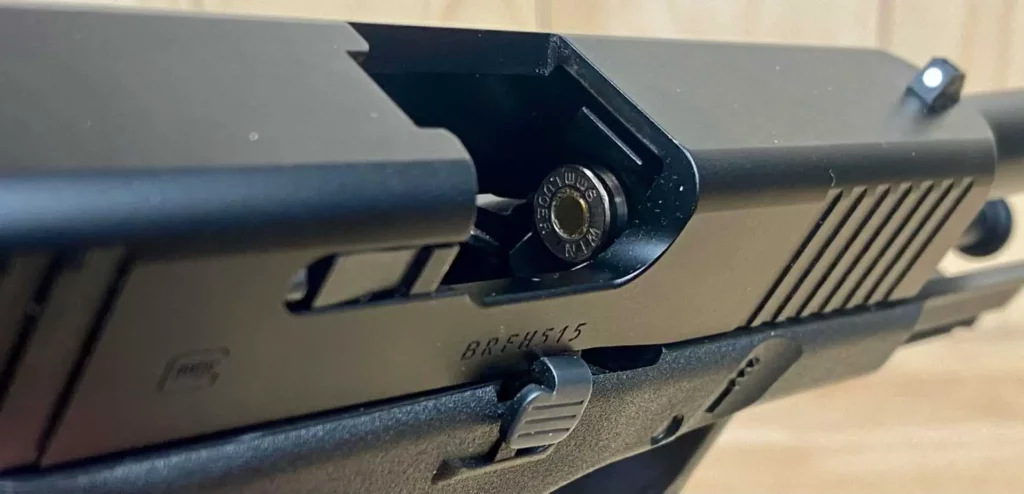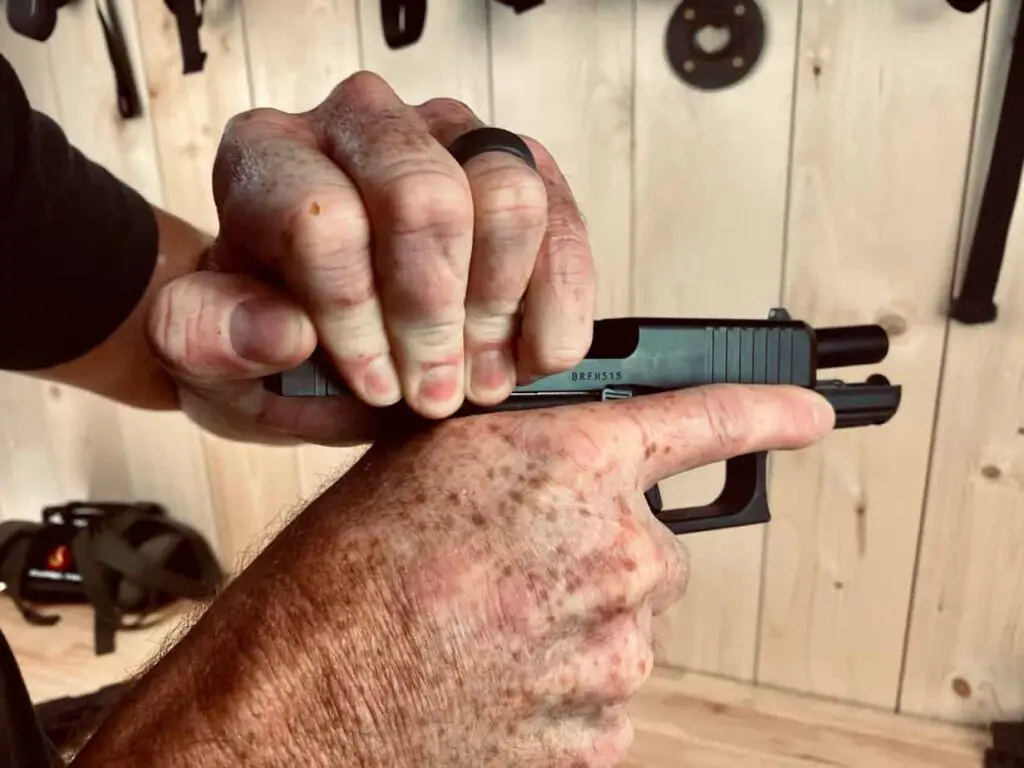“One in the chamber” is a term commonly used in reference to firearms, particularly handguns. It describes a specific condition where a firearm has a round (a single bullet) loaded directly into the chamber of the gun’s barrel. In this context, “chamber” refers to the part of the gun where the bullet is placed, ready to be fired.
When a gun has “one in the chamber,” it means that there is already a bullet in the firing position, and the gun is ready to be fired immediately without the need to chamber a round before shooting. This can have implications for firearm safety and handling.
What does ‘One in the Chamber’ mean in firearms?
In the world of firearms terminology, ‘One in the Chamber’ refers to a specific carrying and readiness condition that can have crucial implications for both safety and effective firearm use.
Definition of “chamber” in firearms:
In firearms, the “chamber” refers to the part of the firearm’s barrel where a single round (bullet) is loaded and positioned for firing.
In addition, it’s the space within the barrel that holds the cartridge—a complete unit consisting of a bullet, propellant (gunpowder), and a primer.
Moreover, when the trigger is pulled, the firing pin strikes the primer, igniting the gunpowder and propelling the bullet out of the barrel.
Description of the condition: Having a loaded round in the chamber:

When a firearm is said to have “one in the chamber,” it means that there is a live round (bullet) loaded directly into the chamber of the gun’s barrel.
Additionally, this configuration allows the gun to be ready for immediate firing without needing to manually load a round into the chamber before shooting. The act of loading a bullet into the chamber is often called “chambering a round.”
To achieve this condition, the user would typically insert a loaded magazine into the gun’s grip (if applicable), rack or cycle the slide (a part of the firearm that moves back and forth), and release it, which chambers a bullet from the magazine into the firing position. This means that the gun is now ready to be fired by simply pulling the trigger.
Implications for firearm readiness and immediate firing:
Having a firearm with one in the chamber increases its readiness for immediate use. In situations where split-second response is critical, such as self-defense scenarios, law enforcement operations, or emergencies.
Moreover, having a loaded chamber can save valuable time that might otherwise be spent manually chambering a round. This can make a difference in ensuring that the firearm is ready to fire when needed.
However, there are significant safety considerations that come with carrying a firearm with one in the chamber. It requires a higher level of awareness and discipline to avoid accidental discharges. Carrying a gun in this state requires a thorough understanding of the firearm’s safety mechanisms and safe handling practices.
What are the key considerations and implications?
Exploring the concept of ‘One in the Chamber’ delves into the pivotal considerations and far reaching implications that arise in firearms handling, encompassing safety, response time, and tactical preparedness.
Safety concerns with a loaded chamber:
Risk of accidental discharge: Carrying a firearm with a loaded chamber increases the risk of accidental discharge, which occurs when the trigger is unintentionally pulled, leading to an unexpected shot.
Additionally, this risk is heightened when the user isn’t accustomed to proper firearm handling techniques, is careless with trigger discipline, or fails to engage the necessary safety mechanisms.
Importance of proper firearm handling: Proper firearm handling is crucial when carrying with one in the chamber.
Moreover, users must be trained to keep their fingers off the trigger until ready to shoot and to only point the firearm at what they intend to shoot.
In addition, basic safety rules like treating every firearm as if it’s loaded and never pointing it at anything you’re not willing to destroy become even more critical in this scenario.
Importance of safety mechanisms:
Overview of common safety features: Many modern firearms incorporate safety mechanisms designed to minimise the risk of accidental discharges. These may include:
- Manual Safety: A switch or lever that, when engaged, prevents the trigger from being pulled.
- Decocker: A mechanism that safely lowers the hammer without firing the gun.
- Trigger Safety: A safety within the trigger that prevents the trigger from moving unless fully depressed.
- Firing Pin Block: A mechanism that prevents the firing pin from striking the primer unless the trigger is pulled.
Role in preventing unintentional firing:
These safety mechanisms play a vital role in preventing unintentional firing when carrying a firearm with one in the chamber.
Additionally, they serve as layers of protection against accidental discharges and provide an extra level of assurance for the user.
However, it’s important to note that relying solely on safety mechanisms is not a substitute for proper training and responsible handling.
Personal preferences and training:
Individual decisions on carrying with one in the chamber: The decision to carry a firearm with one in the chamber is a personal one that varies based on individual comfort, familiarity with firearms.
And the perceived level of threat. Some individuals choose to carry with an empty chamber to reduce the risk of accidental discharges, while others opt for a loaded chamber for the advantage of immediate readiness.
Role of training in safe firearm handling:
Training is paramount for anyone carrying a firearm, especially with one in the chamber. Proper training instils essential skills, including:
- Firearm Familiarity: Understanding the specific firearm’s features, safety mechanisms, and operation.
- Safe Holstering and Drawing: Learning how to holster and unholster the firearm safely to avoid unintentional discharges.
- Trigger Discipline: Developing the habit of keeping the finger off the trigger until ready to fire.
- Emergency Situations: Simulating high-stress scenarios to practise quick and safe decision-making.
What factors influence the choice?

The decision regarding whether to keep ‘One in the Chamber’ is influenced by factors such as individual preferences, situational awareness, firearm type, and training level, all of which shape the balance between readiness and safety.
Self-defence and emergency situations:
Response time when immediate firing is necessary: In high-stress situations, such as self-defence or emergency scenarios, the element of time becomes critical.
Moreover, carrying a firearm with one in the chamber can significantly reduce the time it takes to respond effectively.
Additionally, in a life-threatening situation, having the ability to immediately engage a threat can be a deciding factor in one’s survival or the safety of others.
Considerations for personal protection: For individuals who carry a firearm for personal protection, the decision of having one in the chamber may be based on the specific environment and context in which they anticipate needing the firearm.
In addition, factors such as the crime rate in the area, the individual’s familiarity with potential threats, and their perceived level of risk can influence the choice.
Balance between readiness and safety:
Weighing the benefits and risks: The decision to carry with one in the chamber involves assessing the trade-off between readiness and safety.
On one hand, immediate readiness can be a significant advantage, but on the other hand, it introduces a higher risk of accidental discharges.
Individuals must carefully evaluate the benefits of faster response times against the potential dangers of carrying a firearm that’s more prone to accidental firing.
Adherence to safe firearm practices: Carrying a firearm with one in the chamber requires a strong commitment to safe firearm practices.
Individuals who choose this option must be highly disciplined in following established safety protocols, such as keeping their finger off the trigger until ready to fire.
Moreover, using a proper holster, and engaging any safety mechanisms available on the firearm. Regular training and practice are essential to maintaining these skills.
FAQ’s
Is it safe to have 1 in the chamber?
It can be safe if proper firearm handling protocols are followed, including trigger discipline and safety mechanisms.
What are the rules for one in the chamber?
Rules include keeping fingers off the trigger, using safety mechanisms, and adhering to safe holstering and unholstering techniques.
How safe is a Glock with one in the chamber?
Glocks have safety mechanisms, but safe use depends on following guidelines, training, and maintaining proper holstering practices.
Will a Glock shoot without one in the chamber?
No, a Glock requires a round in the chamber to fire. The firing cycle relies on chambering a round when the slide is racked.
Can a Glock fire accidentally?
Accidental discharges are possible if safety rules aren’t followed. Trigger discipline and proper holstering are crucial to prevent accidents.
What is the Israeli carry method?
The Israeli carry involves carrying a semi-automatic pistol without a round in the chamber, requiring chambering a round before firing. It prioritises safety but may affect response time.
Conclusion
In conclusion, the concept of carrying a firearm with one in the chamber presents a critical balance between readiness and safety. Understanding the nuances and implications associated with this choice is essential for responsible firearm ownership and use.
By examining factors such as the definition of a loaded chamber, safety concerns, the role of safety mechanisms, personal preferences, and the significance of training, individuals can make informed decisions tailored to their specific needs and circumstances.
Moreover, it’s crucial to recognize that while having one in the chamber enhances the potential for swift response in self-defence and emergency situations, it also introduces an elevated level of risk.
Accidental discharges and the importance of proper firearm handling cannot be underestimated, emphasising the necessity of comprehensive training to mitigate these risks effectively.
Ultimately, the decision to carry with one in the chamber should be driven by a deep commitment to safety, a thorough understanding of firearm mechanics, and a continuous dedication to adhering to safe firearm practices.
Finally, by prioritising both personal protection and responsible firearm use, individuals can navigate the complex landscape of firearm readiness with the utmost care and consideration.

